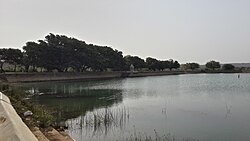This article needs additional citations for verification .(May 2025) |
Samatra | |
|---|---|
village | |
 Umrasar Tadav, Samatra | |
| Coordinates: 23°11′32″N69°29′49″E / 23.192224°N 69.497041°E | |
| Country | |
| State | Gujarat |
| District | Kachchh |
| Languages | |
| • Official | Gujarati, Hindi |
| Time zone | UTC+5:30 (IST) |
| Nearest city | Bhuj |
| Website | http://samatra.org |
Samatra is a village in the Kutch district of Gujarat state, India. [1]

